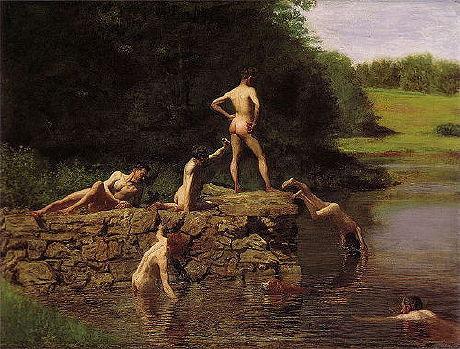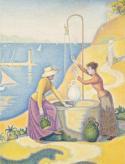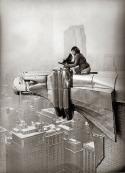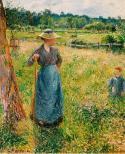Art Of The Day Weekly
#312 - from 8 August 2013 to 11 September 2013

Thomas Eakins, The Swimming Hole, oil on canvas, 1884-85, 70x92 cm, The Amon Carter Museum, Fort Worth, Texas (exhibition Hotel Texas at the Dallas Museum of Art).
30 EXHIBITIONS NOT TO BE MISSED THIS SUMMER
Before the excitement and bounty of exhibits in September, why not enjoy a last chance to take in the ones that met with such success in the spring? From Pissarro to Lichtenstein, from Kennedy to Pasolini, Paris, Dallas or Madrid, here is a personal – and therefore incomplete – selection to beat the summer heat.

Paul Signac, Femmes au puits, ou Jeunes Provençales au puits © RMN-Grand Palais (musée d'Orsay) H.Lewandowski
1 Southern lights
AIX-EN-PROVENCE and MARSEILLE – This is one of the key events of Marseille cultural capital, acting more like a territory since it is organized in two parts. The first is at the musée des Beaux Arts in Marseille, at the palais Longchamp –that reopened for this event-, the second is delocalized to Aix, at the musée Granet. How did the color and light of the South increasingly bewitch the artists? With Signac’s and Van Gogh’s ‘discovery’ trips in the 1880s, the painters brush away the assumption according to which one stays in the South only during the cold season. They also spend the Summer there, nourished by the sun, and at as pilot-fish for the tourists who would not follow them before the 1920s, thanks to the American pioneers described by Scott Fitzgerald in Tender is the night. Of course Cézanne is an important link in this awakening; but Monet, Braque, Matisse, Picasso and Modigliani did not stay behind. This is easily proven by the nearly 200 paintings exposed, on loan from many institutions.
• Le grand atelier du Midi, until 13 October 2013 at the musée Granet (Aix-en-Provence) and the palais Longchamp (Marseille)

Vincent van Gogh (1853-1890), Vincent’s bedroom in Arles, 1888. Oil on canvas, 72 x 90 cm Van Gogh Museum, Amsterdam (Vincent van Gogh Foundation).
2 A close look at Van Gogh
AMSTERDAM – The focus of the exhibition that curators and experts have been perfecting it for eight years is very simple: Van Gogh at work. In depth X-ray and microscope analysis have succeeded in finding sand stuck on certain canvases. This proves the artist worked outdoors. They found pieces of newspaper, used to protect the painting. Research can now determine the pigments, the paintbrushes and the degree of the oil paint dilution. The artist’s notebooks, his letters, his tubes and his unique palette –on loan from the musée d’Orsay will also be exposed, thus giving this superstar of art his human dimension.
• Van Gogh at work at the Van Gogh Museum, until 13 January 2014.
3 Nolde, master of colors
BADEN-BADEN – This retrospective of the German painter's whole career includes in particular landscapes and portraits, as well as a few watercolors he called "non-painted paintings" - done when the Nazis forbid him from painting.
• Emil Nolde at the Frieder Burda Museum, until 13 October 2013.
4 Max Ernst is back
BASEL - Max Ernst (1891-1976) is one of the giants of modern art. A dynamic artist, he has gone through all the avant-gardes of the XXth century, and has expressed himself with sand as well as with tree imprints, drawings and sculptures. Some 180 works, with a strong representation of his Dadaist period, offer a complete retrospective of this unique creator one cannot classify, who also appeared in the gossip columns with his ‘ménage à trois’ with Paul Eluard and Gala, who later went to Dali’s arms …
• Max Ernst at the fondation Beyeler, until 8 September 2013.
5 Pasolini Roma
BARCELONA - Pasolini spent exactly 25 years in Rome, from his arrival in 1950 until his death when he was murdered in the eternal city in November 1975 on the beach of Ostia. He was extremely productive during that quarter of a century, with movies -Accattone, Medea, the gospel according to Matthew, etc-, novels, among which Ragazzi di vit. And not only: he wrote articles with violent criticism of the consumer society. A friend of Moravia, of Elsa Morante, Anna Magnani and Maria Callas, he was one of the pillars of the Roman post-war intellectual life. This exhibition brings him back to life through documents, works and testimonials of his time.
• Pasolini Roma at CCCB, until 15 September 2013.
6 Meret Oppenheim, the Surrealist muse
BERLIN – She was a friend and an inspiration to Man Ray, Elsa Schiaparelli and even Hans Arp. Meret Oppenheim (1913-1985) was a woman with a passion for the avant-gardes, and she left her mark on the first half of the 20th century, both as a muse as well as an artist in her own right.
• Meret Oppenheim at the Martin-Gropius-Bau, from 16 August to 1 December 2013.
7 Albert Kahn, world knowledge
BOULOGNE-BILLANCOURT – As a wealthy patron he financed a photographic investigation on the state of the planet at the beginning of the 20th century. Little dit it matter that he went broke with the crisis in 1929: the dozens of photographers he sent to the five continents have produced unique archives.
• A la recherche d’Albert Kahn at the musée Albert Kahn, until 21 December 2013.
8 Morandi, the master of still-life
BRUSSELS – He is one of the masters of still lives, a sort of Chardin of the XXth century. Giorgio Morandi (1890-1964), discreet and homely, has produced in his workshop in Bologna an unlimited number of bottles, pots and pitchers that have all become icons of the silent life of things. He is watchful of all the avant-gardes he has rubbed elbows with - Surrealism, Futurism, metaphysical painting. But he has always remained deeply independent. He was defended by Roberto Longhi, the deus ex machina of Italian art, and won the Grand Prix of the Biennale of Venice in 1948. Yet he never changed his firm old bachelor ways. Some one hundred works from the best collections, in particular from Museo Morandi, MART, fondazione Magnani Rocca, fondazione Longhi, will be confronted to contemporary interpretations by Luc Tuymans and Claudio Parmiggiani.
• Giorgio Morandi at Bozar, until 22 September 2013.
9 In the Kennedy suite
DALLAS - Art historian Olivier Meslay presents a very original and moving exhibition fifty years after the assassination of John Fitzgerald Kennedy in Dallas. He has brought together the collection of works that had been put together in suite 850 of the Texas Hotel at Fort Worth, where the presidential couple spent their last night before the drama. The loans from local collectors included works by Van Gogh, Picasso, Eakins, Henry Moore, etc.
• Hotel Texas at the Dallas Museum of Art, until 5 September 2013.

Paris Bordon, Venus, Flora, Mars and Cupid (Allegory). Oil on canvas, 108x129 cm, 1550s. Courtesy The State Hermitage Museum, Saint Petersburg.
10 From Saint Petesburg with love
HOUGHTON HALL (Norfolk) –Sir Robert Walpole (1676-1745) is seen as the creator of the modern function of Prime Minister. The leader of the Whigs, architect of English politics up to the unlucky war against Spain known as the War of Jenkins’ Ear, he built a considerable fortune and a no-less famous collection of paintings. His son, writer Horace Walpole, kept it up but is grandson squandered it. Catherine the Great bought the most beautiful pieces, in a series of sales that have remained famous, and set them up in the Hermitage. More than two centuries after the hemorrhage, some sixty paintings, from Van Dyck to Rembrandt, are once again set up where they used to be at the end of the XVIIIth century at Houghton Hall, in Norfolk. The castle is still inhabited by a descendant of Robert Walpole, the Marquess of Cholmondeley.
• Houghton Revisited – Masterpieces from the Hermitage at Houghton Hall, until 29 September 2013.
11 Turrell, the light man
HOUSTON-LOS ANGELES-NEW YORK - In Europe he is known for a few beautiful installations, during the Nuit blanche in Paris, at the Louise Blouin Foundation in London, or during the Biennale of Venice in 2011. The time has come for James Turrell to be consecrated. The California artist, who just turned 70, is the subject of three important retrospectives. All three will open less than a month after the previous one, in Los Angeles, New York and Jerusalem. It is not easy to exhibit this artist, for he has made light his main material, as it is inseparable from space. As the good Quaker that he is, faith, contemplation, rigor and silence are complementary virtues. His great masterpiece is still in the making, in the cone of the extinct Roden volcano, in Arizona, where spirals, tunnels and an observatory will reflect the natural light and the artificial light. While waiting for it to be finished, the pore fortunate may spend some time at the Estancia Colomé, near Salta, in Argentina. Founded by billionaire Donald Hess, it holds the only museum completely dedicated to Turrell’s work.

Peter Paul Rubens, Ann of Austria, Queen of France, oil on canvas, ca. 1622 © Museo Nacional del Prado, Madrid
12 Rubens, a European champion
LENS – Was Europe already a global society back in the XVIIth century? The popularity of an artist such as Rubens (1577-1640), whom all the courts of the continent fought over, seems to prove it. Some 170 works by the master, by his contemporaries and of those who influenced him – from a Roman Centaur ridden by Eros to the Great Cameo of France) decrypt the myth of a multi-disciplinary genius, a painter, diplomat and leader of a workshop with the dimensions of an industrial plant.
• L’Europe de Rubens at the Louvre Lens, until 23 September 2013.
13 Lowry, an unknown giant
LONDON - In the Lowry family we know Malcolm, the author of Under the volcano, or Glen the director of the MoMA these last twenty years. Now we have a new member who is making a name for himself. Laurence Stephen, known as L.S. He is not really unknown. The English think very highly of their compatriot. But he is not what you would call a household name abroad. Yet this painter lived a very full life -1887-1976. More than any other he was capable of capturing the atmosphere of an industrial society on the wane, the poetry of the workes' quarters, the texture of the large brick plants, the silent crowds in the railway stations. But he also depicted the tragedies of the mine and the illnesses that destroyed populations without any resources at the very beginning of generalized social welfare. He had an independent mind and was allergic to official recognition. More than once he refused the honor of the Order of the British Empire. Lowry is the worthy heir of the Impressionists and the Symbolists. As we near the 50th anniversary of his death the Tate Britain pays a tribute to him as a major figure of the XXth century.
• Lowry and the Painting of Modern Life at the Tate Britain, until 20 October 2013.

Paulus Moreelse, Portrait of a Young Boy, 1634. Oil on canvas. Royal Collection © Her Majesty Queen Elizabeth II
14 The strait laced Tudors
LONDON -In the past little boys also wore dresses… and the dictatorship of fashion is not something new. These facts are particularly well shown in this selection of royal collections and show the splendors of the courts of the Tudor and Stuart dynasties. A real accumulation of blue blood, it shows Ann of Denmark, the great Elizabeth, Charles II and even Marie of Modena as well as portraits of enriched bourgeois, such as this little boy cramped in his dress and holding a coral rattle to soothe his teeth. The painters scrupulously reproduced the sumptuous materials – lace, taffetas, ruffles, braids and gold materials. Holbein, Steen, Hoskins, Rembrandt and Pourbus are some of the great names who at that time played the part of history reporters.
• In Fine Style: the Art of Tudor and Stuart Fashion at the Queen’s Gallery, until 6 October 2013.
15 Pissarro, the top Impressionist
MADRID – He is the number one Impressionist artist, the one who drew up the by-laws of the group and he is the only one among the “major” ones to have taken part in all the eight collective exhibitions held between 1874 and 1886. Yet, as the curators of the retrospective rightly explain, his aura was dimed by that of his colleagues, Monet the first. So this event is a sort of rehabilitation with an additional value since it is held out of France, where the Impressionist galaxy is even more reduced to its heavy weight champions. Over 80 works - views of the Seine, Parisian perspectives, portraits and self-portraits –and among them the venerable with the long white beard – show how Pissarro was a gifted guardian of the temple. But he never dared the chromatic audacities Monet imagined or the virtuoso group scenes Renoir was so successful at.
• Camille Pissarro at the museo Thyssen-Bornemisza, until 15 September 2013.

Margaret Bourke-White working on top of the Chrysler Building, New York, New York, 1935. © Photo : Oscar Graubner / Time Life Pictures / Getty Images
16 Vertigo way up high
METZ – How can we see the Earth from the sky? Artists did not wait for the successful campaign made by photographer Arthus-Bertrand to ask them selves the question. The members of the De Stijl movement wondered where to place the vanishing point. Contemporary artists use images from military drones in their videos. From Nadar to the recent low-angle images of North Korean parades by Andreas Gursky, including Delaunay diving on the Eiffel Tower or the aeropittura of the Italian Futurists, the exhibition shows how this thirst for a general vision marked the history of art.
• Vues d’en haut at the Centre Pompidou Metz, until 7 October 2013.
17 Zavattini as a collector
MILAN - Cesare Zavattini (1902-1989) was a great Italian screenwriter but a collector and painter as well. But he was interested in one single format, the 8 x 10 cm, of which he had a collection of 1500 works. In this series, the Pinacoteca di Brera shows a series of 152 self-portraits it was able to buy last year.
• Cesare Zavattini at Pinacoteca di Brera, until 8 September 2013.
18 Nordic Winds
MUNCHEN – Why did Scandinavian art have such success at the turn of the 1900s? The exhibition tries to answer this question by showing Munch, Hammershoi, Gallen-Kallela, Carl Larsson or lesser-known artists like Anna Ancher or Eugène Jansson.
• Nordic Art at Hypo Kunsthalle, until 6 October 2013.
19 Focus on Le Corbusier
NEW YORK – The publication of the architect's Journal has recently revealed a whole part of the architect's intimate life. Le Corbusier is now the object of a complete retrospective that explores his relationship to landscapes.
Le Corbusier at MoMA, until 23 September 2013.

Michelangelo Pistoletto, Scultura da passeggio, performance in London, June 2009. Courtesy Tate Modern, Londres.
20 Pistoletto, the wealth of poor art
PARIS - He is past the age of 80, and yet he is everywhere! Michelangelo Pistoletto, once the pope of Arte povera with Jannis Kounellis and Luciano Fabro, has just inaugurated an installation at the Louvre, symbolizing the new links the museum has with contemporary art. He who became famous with his mirrors and his stacks of rags and paper has also reedited a famous performance, Sculpture de promenade, the first one having been almost half a century earlier. Under the pouring rain during the Nuit des musées on 18 May, he had his mobile sculpture fly from the Monnaie building to the pyramid of the Louvre. Pistoletto has never been as active as he is these last few years, designing coffee cups for Illy, wine bottle labels, drawing up theories with his concept of a third Renaissance or as a cultural facilitator at the Cittadellarte, at home back in Biella, in the Piedmont region, Pistoletto seems more active than ever. At the height of a “youth crisis”, it seems the older generation is at the top of everything!
• Michelangelo Pistoletto, Année 1, le paradis sur terre at the musée du Louvre until 2 September 2013.
21 Ratton, the call from beyond
PARIS – Like many others in his time, he was at the crossroads of various currents, had a passion for Medieval Art, was active in the Surrealist movement but above all was the great discoverer of what is called the primitive arts. A well-known gallery owner, a friend of Tzara, of Man Ray, of Matisse Jr, Charles Ratton (1897-1986) had remarkable works go through his hands, before being added to the collections of the greatest museums in the world. An emblematic example is the statuette of Queen Bangwa, from the collection of Helena Rubinstein, the queen of cosmetics, and which was the first African work of art to compete -by its price- with traditional art during a sale in New York in 1966. It was present by the intermediary of a photograph by Man Ray. Some 200 works trace the itinerary of the art dealer who furthered widened his centers of interest after the war by knitting a close relationship with Dubuffet and art brut.
• Charles Ratton, l’invention des arts primitifs at musée du quai Branly, until 22 September 2013.
22 Johannesburg, global city
PARIS – What is the contemporary art scene like in the main city of South Africa ? The exhibition brings together major names such as David Goldblatt or William Kentridge.
• My Joburg at Maison rouge, until 22 September 2013.
23 The French touch of the Bouroullec
PARIS – Given their fame and influence, they are worthy heirs of Philippe Starck. As they reach a turning point in their activity – their first 15 years of design production -, brothers Ronan and Erwan Bouroullec are put under close scrutiny.
• Ronan et Erwan Bouroullec at the musée des Arts décoratifs until 1 September 2013.
24 Works of art, your ID please!
PARIS – How does an object reach the status of a work of art? That is the question this transdisciplinary exhibition addresses, skipping centuries, from the art of the pharaohs to the provocative works by Gilbert & George.
• Le théorème de Nefertiti at the Institut du monde arabe, until 8 September 2013.
25 The mechanism of spoliation
PARIS – In France as in other countries, the Nazi Occupation was accompanied by a wide network of accomplices to carry out a systematic policy of spoliation of Jewish property (painter Gérard Garouste describes in his autobiography L’Intranquille the example of his own father). Here is a proof that summer does not only bring out easy, mellow exhibitions.
• La spoliation des Juifs, une politique d’Etat (1940-44) at the Mémorial de la Shoah, until 29 September 2013.
26 Chaissac-Dubuffet, a wealthy correspondence
PARIS – These two heavy weights of art brut did not meet by chance: Chaissac and Dubuffet were very close and exchanged an abundant correspondence. The exhibition is articulated around these letters.
• Chaissac et Dubuffet, entre plume et pinceau at L’Adresse Musée de la Poste, until 28 September 2013.
27 Another Lichtenstein
PARIS – Roy Lichtenstein (1923-1997) was the first to merge painting and comic strips, to transcend the framework of contemporary art. Lichtenstein was the most famous pop artist next to Warhol and a wise manipulator of the codes of consumer society. But he was more than a machine to enlarge comic strips. He experimented with various materials and techniques, in particular with sculpture, he produced a series inspired by Matisse (the Artist’s Studios from 1973-74), turned towards nudes in the 1990s and delved on landscapes close to those of the Song in China when he died…
• Roy Lichtenstein at the Centre Pompidou, until 4 November 2013.

Guy Debord, Dépassement de l'art, 17-06-1963, oil on canvas, 41,5 x 60,2 cm. Collection Letaillieur / Courtesy Galerie 1900-2000. © Letaillieur
28 The colors of philosophy
SAINT-PAUL-DE-VENCE - Philosophers who paint, painters who philosophy…We’ve seen that before. But the game between painters and philosophers goes beyond this simple game of ping-pong. How cab philosophy be disturbed by the simple idea of representation? How can painting embody a concept? Can we paint Hegel’s thoughts? These and other similar questions are intricate, be it recondite. Bernard Henri Lévy wishes to give his personal answers, for his strongest desire is no doubt to create debates around them. Indeed, the former “young philosopher" is the curator of the great exhibition this summer at the Fondation Maeght. From Bronzino as Kosuth, to Picabia as Basquiat, or Abramovic as Cattelan, as seen through short movies done by BHL himself, it is a disconcerting and debatable itinerary.
• Les aventures de la vérité at the Fondation Maeght, until 6 October 2013.
29 Lartigue, the eternal
TOULON – His rule in life was to be a dilettant. Jacques-Henri Lartigue was from a wealthy family, loved beautiful women, cars, tennis and casinos, and for a long time he took photographs for his own pleasure. It took the economic crisis and his need to make a living for him to turn to painting… Throughout his life he was faithful to one love, that of the Côte d’Azur and the mundane seaside resorts. These images are reminiscent of the unswerving link between Biarritz, Deauville and Nice, where he passed away at the age of 92 in 1986, leaving 100 000 negatives.
• Rivages at the Maison de la photographie, until 29 September 2013.
30 Not really a Looser
ZURICH – The Collection Hubert Looser of contemporary art (from de Kooning to Picasso and Arte Povera), which shall add to the museum’s holdings in 2017, can be glimpsed through a “preview” at the Kunsthaus.
• Looser Collection at Kunsthaus Zurich until 8 September 2013.

